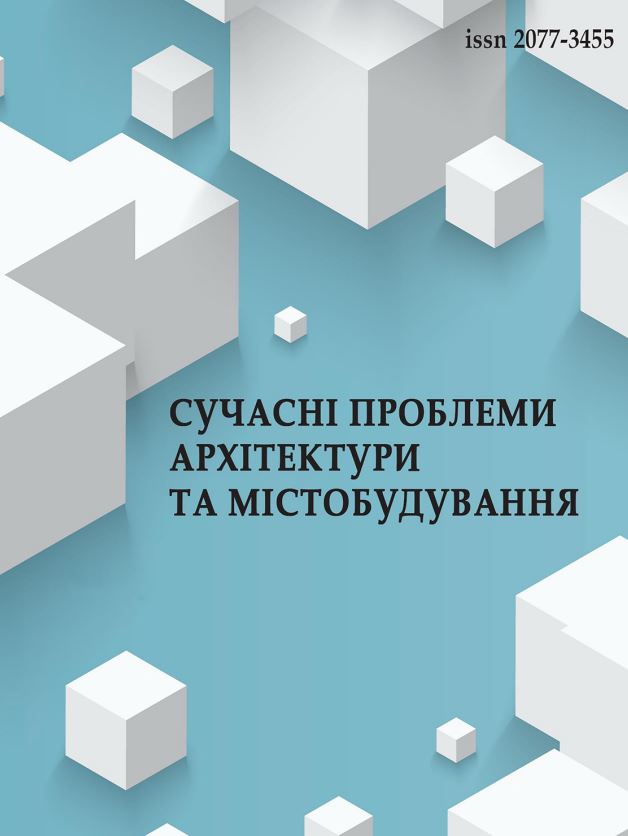СТРУКТУРА ПОНЯТТЯ «КОМФОРТ»
DOI:
https://doi.org/10.32347/2077-3455.2025.72.297-306Ключові слова:
комфорт, архітектура, структура поняття, суб’єктно-орієнтоване проєктування, середовище, адаптивність, сенсорне сприйняття, просторовий сценарійАнотація
У статті здійснено теоретичний аналіз структури поняття «комфорт» у контексті архітектурного проєктування. Автором розглянуто еволюцію трактування комфорту — від техніко-інженерного підходу до інтегративного розуміння, що охоплює фізичні, психологічні, соціальні та емоційні складові. Запропоновано структурну модель цього поняття, яка включає базові рівні: фізіологічний, сенсорний, сценарний та когнітивно-смисловий. Показано, що комфорт є багатовимірною динамічною категорією, яка формується на перетині об’єктивних умов середовища й суб’єктивного сприйняття користувача. Обґрунтовано доцільність переходу до суб’єктно-орієнтованих принципів проєктування, де структура комфорту стає основою для формування адаптивного архітектурного середовища.
Посилання
Список джерел
Song Y., Mao F., Liu Q. Human comfort in indoor environment: a review on assessment criteria, data collection and data analysis methods. IEEE Acces, Vol. 7, 2019. P.119774-119786. DOI: https://doi.org/10.1109/ACCESS.2019.2937320
Юхименко Н.Ф. Духовні потреби як фактор становлення діяльно-творчої особистості. Вчені записки ТНУ імені В.І. Вернадського. Серія: Філософія. Том 31 (70) № 2 2020. C. 61-66. DOI: https://doi.org/10.32838/2709-2933/2020.2/11
Lorenzino M., Bregant L., D’Agostin F. The importance of psychophysiological factors in comfort studies. Journal of Ergonomics, Vol.11 Iss.S1 No:10000001. P.1-4. DOI: https://doi.org/10.1109/ACCESS.2019.2937320
Wang H., Liu L. Experimental investigation about effect of emotion state on people’s thermal comfort. Energy and Buildings. 2020. Vol. 211(2). Article 109789. DOI: https://doi.org/10.1016/j.enbuild.2020.109789
Choi C., Kim K., Kim C., Kim S., Choi W. Reactivity of heart rate variability after exposure to colored lights in healthy adults with symptoms of anxiety and depression. International Journal of Psychophysiology. 2011. Vol. 79. P. 83–88. DOI: https://doi.org/10.1016/j.ijpsycho.2010.09.011
Park S. H., Lee P. J., Jeong J. H. Effects of noise sensitivity on psychophysiological responses to building noise. Building and Environment. 2018. Vol. 136. P. 302–311. DOI: https://doi.org/10.1016/j.buildenv.2018.03.061
Västfjäll D. Influences of current mood and noise sensitivity on judgments of noise annoyance. The Journal of Psychology. 2002. Vol. 136(4). P. 357–370. DOI: https://doi.org/10.1080/00223980209604163
Thomas J. R., Jones D. M. Individual differences in noise annoyance and the uncomfortable loudness level. Journal of Sound and Vibration. 1982. Vol. 82(2). P. 289–304. DOI: https://doi.org/10.1016/0022-460X(82)90536-3
Standing L., Lynn D., Moxness K. Effects of noise upon introverts and extroverts. Bulletin of the Psychonomic Society. 1990. Vol. 28. P. 138–140. DOI: https://doi.org/10.3758/BF03333987
Mahdavi A. Explanatory stories of human perception and behavior in buildings. Building and Environment. 2020. Vol. 168. Article 106498. DOI: https://doi.org/10.1016/j.buildenv.2019.106498
Kamiya A., Kawada T., Shimizu S., et al. Relationship between spectral components of cardiovascular variabilities and direct measures of muscle sympathetic nerve activity in humans. American Journal of Physiology - Heart and Circulatory Physiology. 2000. Vol. 279. P. H303–H309. DOI: https://doi.org/10.1161/01.cir.95.6.1441
References
Song, Y., Mao, F., & Liu, Q. (2019). Human comfort in indoor environment: A review on assessment criteria, data collection and data analysis methods. IEEE Access, 7, 119774–119786. https://doi.org/10.1109/ACCESS.2019.2937320 (in English)
Yukhymenko, N. F. (2020). Dukhovni potreby yak faktor stanovlennia diialno-tvorchoi osobystosti [Spiritual needs as a factor of the formation of an active and creative personality]. Vcheni zapysky TNU imeni V. I. Vernadskoho. Seriia: Filosofiia, 31(70), 2, 61–66. https://doi.org/10.32838/2709-2933/2020.2/11 (in Ukrainian)
Lorenzino, M., Bregant, L., & D’Agostin, F. (2021). The importance of psychophysiological factors in comfort studies. Journal of Ergonomics, 11(S1), 1–4. https://doi.org/10.1109/ACCESS.2019.2937320 (in English)
Wang, H., & Liu, L. (2020). Experimental investigation about effect of emotion state on people’s thermal comfort. Energy and Buildings, 211, 109789. https://doi.org/10.1016/j.enbuild.2020.109789 (in English)
Choi, C., Kim, K., Kim, C., Kim, S., & Choi, W. (2011). Reactivity of heart rate variability after exposure to colored lights in healthy adults with symptoms of anxiety and depression. International Journal of Psychophysiology, 79, 83–88. https://doi.org/10.1016/j.ijpsycho.2010.09.011 (in English)
Park, S. H., Lee, P. J., & Jeong, J. H. (2018). Effects of noise sensitivity on psychophysiological responses to building noise. Building and Environment, 136, 302–311. https://doi.org/10.1016/j.buildenv.2018.03.061 (in English)
Västfjäll, D. (2002). Influences of current mood and noise sensitivity on judgments of noise annoyance. The Journal of Psychology, 136(4), 357–370. https://doi.org/10.1080/00223980209604163 (in English)
Thomas, J. R., & Jones, D. M. (1982). Individual differences in noise annoyance and the uncomfortable loudness level. Journal of Sound and Vibration, 82(2), 289–304. https://doi.org/10.1016/0022-460X(82)90536-3 (in English)
Standing, L., Lynn, D., & Moxness, K. (1990). Effects of noise upon introverts and extroverts. Bulletin of the Psychonomic Society, 28, 138–140. https://doi.org/10.3758/BF03333987 (in English)
Mahdavi, A. (2020). Explanatory stories of human perception and behavior in buildings. Building and Environment, 168, 106498. https://doi.org/10.1016/j.buildenv.2019.106498 (in English)
Kamiya, A., Kawada, T., Shimizu, S., et al. (2000). Relationship between spectral components of cardiovascular variabilities and direct measures of muscle sympathetic nerve activity in humans. American Journal of Physiology - Heart and Circulatory Physiology, 279, H303–H309. https://doi.org/10.1161/01.cir.95.6.1441 (in English)
##submission.downloads##
Опубліковано
Як цитувати
Номер
Розділ
Ліцензія
Авторське право (c) 2025 Болгарова Наталя Миколаївна

Ця робота ліцензується відповідно до Creative Commons Attribution-NonCommercial 4.0 International License.
Автори, які публікуються у цьому журналі, погоджуються з наступними умовами:
Автори залишають за собою право на авторство своєї роботи та передають журналу право першої публікації цієї роботи на умовах ліцензії Creative Commons Attribution License, котра дозволяє іншим особам вільно розповсюджувати опубліковану роботу з обов'язковим посиланням на авторів оригінальної роботи та першу публікацію роботи у цьому журналі.
Автори мають право укладати самостійні додаткові угоди щодо неексклюзивного розповсюдження роботи у тому вигляді, в якому вона була опублікована цим журналом (наприклад, розміщувати роботу в електронному сховищі установи або публікувати у складі монографії), за умови збереження посилання на першу публікацію роботи у цьому журналі.
Політика журналу дозволяє і заохочує розміщення авторами в мережі Інтернет (наприклад, у сховищах установ або на особистих веб-сайтах) рукопису роботи, як до подання цього рукопису до редакції, так і під час його редакційного опрацювання, оскільки це сприяє виникненню продуктивної наукової дискусії та позитивно позначається на оперативності та динаміці цитування опублікованої роботи (див. The Effect of Open Access).

